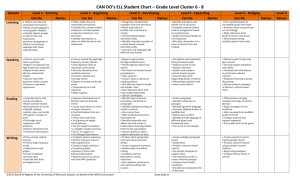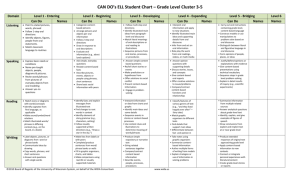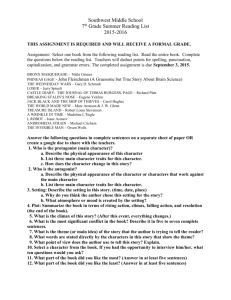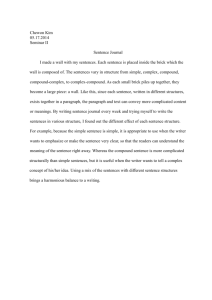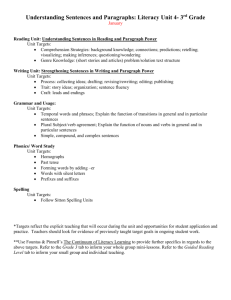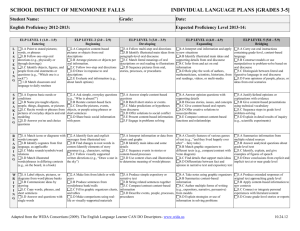File - Middle Creek IRT website
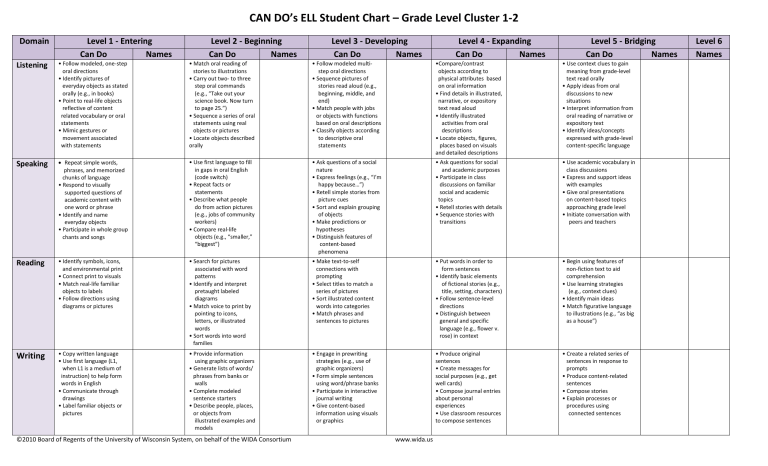
CAN DO’s ELL Student Chart – Grade Level Cluster 1-2
Domain
Listening
Level 1 - Entering
Can Do
• Follow modeled, one-step
oral directions
• Identify pictures of
everyday objects as stated
orally (e.g., in books)
• Point to real-life objects
reflective of content related vocabulary or oral statements
• Mimic gestures or
movement associated with statements
Names
Level 2 - Beginning
Can Do
• Match oral reading of
stories to illustrations
• Carry out two- to three step oral commands
(e.g., “Take out your science book. Now turn to page 25.”)
• Sequence a series of oral
statements using real
objects or pictures
• Locate objects described orally
Names
Level 3 - Developing
Can Do
• Follow modeled multi- step oral directions
• Sequence pictures of stories read aloud (e.g., beginning, middle, and end)
• Match people with jobs
or objects with functions
based on oral descriptions
• Classify objects according to descriptive oral statements
Names
Speaking
Reading
Writing
Repeat simple words,
phrases, and memorized
chunks of language
• Respond to visually supported questions of academic content with one word or phrase
• Identify and name everyday objects
• Participate in whole group
chants and songs
• Identify symbols, icons,
and environmental print
• Connect print to visuals
• Match real-life familiar
objects to labels
• Follow directions using
diagrams or pictures
• Copy written language
• Use first language (L1,
when L1 is a medium of
instruction) to help form
words in English
• Communicate through
drawings
• Label familiar objects or
pictures
• Use first language to fill in gaps in oral English
(code switch)
• Repeat facts or statements
• Describe what people do from action pictures
(e.g., jobs of community workers)
• Compare real-life objects (e.g., “smaller,”
“biggest”)
• Search for pictures associated with word patterns
• Identify and interpret pretaught labeled diagrams
• Match voice to print by pointing to icons, letters, or illustrated words
• Sort words into word
families
• Provide information using graphic organizers
• Generate lists of words/
phrases from banks or walls
• Complete modeled
sentence starters
• Describe people, places,
or objects from illustrated examples and models
• Ask questions of a social
nature
• Express feelings (e.g., “I’m happy because…”)
• Retell simple stories from picture cues
• Sort and explain grouping of objects
• Make predictions or
hypotheses
• Distinguish features of
content-based phenomena
• Make text-to-self
connections with
prompting
• Select titles to match a
series of pictures
• Sort illustrated content
words into categories
• Match phrases and
sentences to pictures
• Engage in prewriting
strategies (e.g., use of
graphic organizers)
• Form simple sentences
using word/phrase banks
• Participate in interactive
journal writing
• Give content-based
information using visuals
or graphics
©2010 Board of Regents of the University of Wisconsin System, on behalf of the WIDA Consortium www.wida.us
Level 4 - Expanding
Can Do
•Compare/contrast objects according to physical attributes based on oral information
• Find details in illustrated, narrative, or expository text read aloud
• Identify illustrated activities from oral descriptions
• Locate objects, figures,
places based on visuals and detailed descriptions
• Ask questions for social and academic purposes
• Participate in class
discussions on familiar
social and academic topics
• Retell stories with details
• Sequence stories with
transitions
Names
• Put words in order to form sentences
• Identify basic elements of fictional stories (e.g., title, setting, characters)
• Follow sentence-level
directions
• Distinguish between
general and specific
language (e.g., flower v.
rose) in context
• Produce original sentences
• Create messages for social purposes (e.g., get well cards)
• Compose journal entries about personal experiences
• Use classroom resources to compose sentences
Level 5 - Bridging
Can Do
• Use context clues to gain
meaning from grade-level
text read orally
• Apply ideas from oral
discussions to new
situations
• Interpret information from
oral reading of narrative or
expository text
• Identify ideas/concepts
expressed with grade-level
content-specific language
Level 6
Names Names
• Use academic vocabulary in
class discussions
• Express and support ideas
with examples
• Give oral presentations
on content-based topics
approaching grade level
• Initiate conversation with peers and teachers
• Begin using features of
non-fiction text to aid
comprehension
• Use learning strategies
(e.g., context clues)
• Identify main ideas
• Match figurative language
to illustrations (e.g., “as big
as a house”)
• Create a related series of
sentences in response to
prompts
• Produce content-related
sentences
• Compose stories
• Explain processes or
procedures using connected sentences

